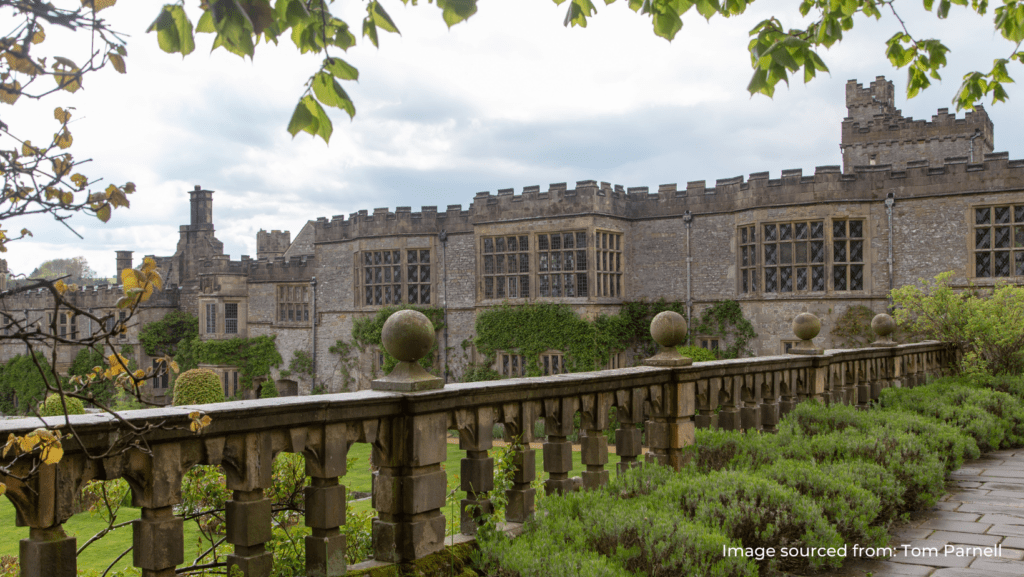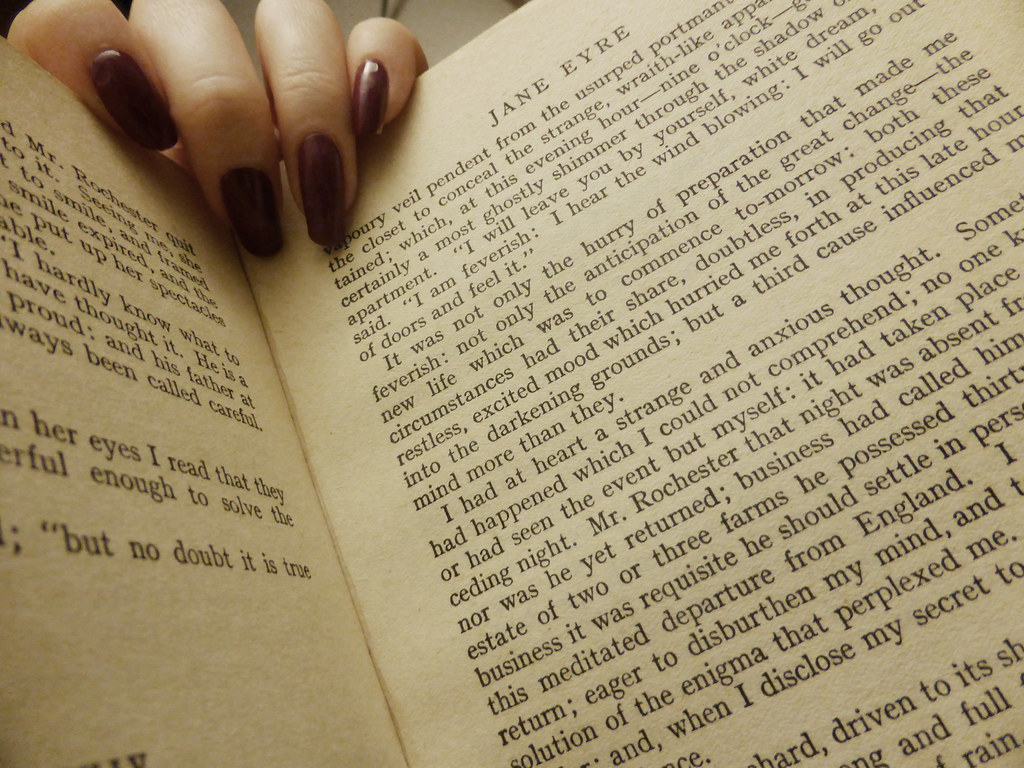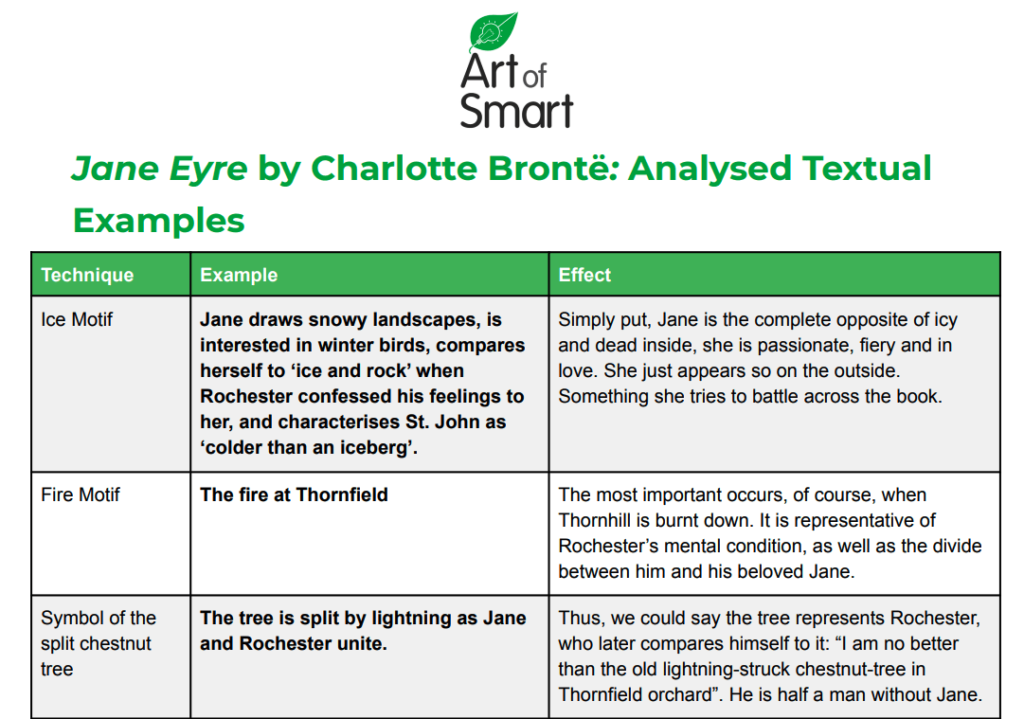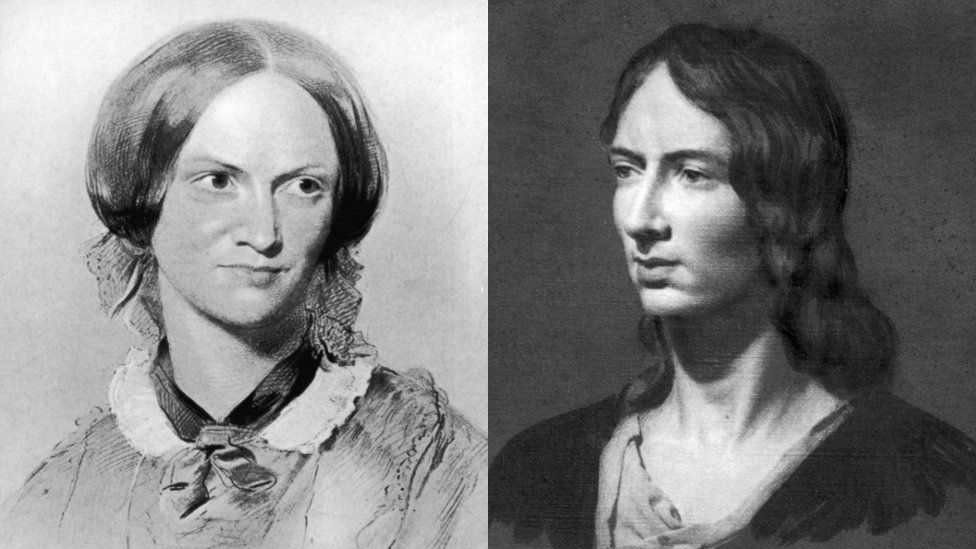Jane Eyre follows the journey of an orphaned governess as she faces challenges of love, identity, and class while striving for self-fulfilment in Victorian England. We’ve made a handy guide with a book summary, key characters, and themes to boost your essay analysis of Jane Eyre!
You’ll also be able to download a copy of analysed textual examples and a sample paragraph at the end!
So what are you waiting for? Let’s get started!
Jane Eyre Book Summary
Key Characters in Jane Eyre
Context
Themes Explored in Jane Eyre
Analysis of Jane Eyre
What is Jane Eyre about?
Jane Eyre is the story of a young orphaned girl, who, in the first phases of the book is mistreated and abused, starved and malnourished, at the orphan house of Lowood.
An epidemic of typhus sweeps through the place, taking away her few friends, including Helen Burns, the best Jane had. She thus decides to leave Lowood at eighteen, and fend for herself with a new job as a governess at Thornfield Hall.
The job she has accepted to carry out involves teaching a young girl, Adèle Varens, daughter of the owner of Thornfield Hall, Mr. Rochester. Jane meets Mr Rochester by chance one night, as he falls off his horse on the way to the Hall. The two are immediately interested in each other.
Image sourced from Liz Lux
Rochester realises he is able to count on Jane for almost anything, as one night the curtains of his room mysteriously catch fire. Jane puts out the fire and saves Rochester, and the pair fall for each other.
Even when he invites rich dames to flirt at his house, he only has eyes for Jane. In the meantime, Jane hears strange noises in the attic, and notices Grace Poole, a servant, behaving oddly.
Richard Mason arrives during this time, a man Rochester seems to know and be afraid of. In the middle of the night, Mason gets stabbed and bitten. Jane tends to his wounds and Rochester sneaks him out of the house.
Rochester and Jane attempt to get married in the chapel, but two men interrupt the ceremony, claiming Rochester is already married.
Rochester reluctantly leads the wedding party to the attic, which holds Bertha Mason, Rochester’s insane, previous wife. She is the one responsible for attempting to burn Rochester in his bed, and for attempting to kill her brother Richard.
Jane, in shock, leaves Thornfield and travels to Morton, a town in which her uncle Mr. Eyre lives. This plan doesn’t go well, however, as she must beg for food and sleep by the side of the road in the beginning.
There she meets her cousins, Diana, Mary and the clergyman St. John. The latter wants to be more than just “cousins” with Jane, so they have a small fling that does not last. As uncle Eyre dies, Jane inherits a bit of his fortune.
She travels back to Thornhill, to find out what’s up with Rochester. After attempting to find her, he has shut himself in the house alone. Bertha then burns down Thornhill and commits suicide, but the fire loses Rochester an eye, and blinds him in the other.
When Jane finds him, he begs her to come to France with him and pretend to be married, but she refuses, in the hopes that he will marry her for real.
He does! They live happily ever after, and Rochester gains his sight back. Meanwhile, St. John works himself to death as a missionary in India.
Need help getting through Jane Eyre? The book can get a little intense. Why not get matched with an English tutor who can help?
Key Characters in Jane Eyre
Jane Eyre
If it was up to Jane, she wouldn’t say she had a character to speak of. She is a resilient, strong, yet quiet woman, who wouldn’t really admit her potential.
She is careful both in speech and in thought; this is why the reader often finds out her feelings and opinions before she does. For example, it’s as clear as day that she likes Rochester, even before she explicitly tells us and realises it herself.
Rochester
An intense, moody, stubborn, fascinating, and incredibly intelligent counterpart to Jane. We can call Mr. Rochester ‘careful’ also, but when it comes to his actions, he knows exactly what to do and when to do it. Except when he falls in love.
The whole flirtation with the dames was a clumsy move, and the entertainment of the possibility that he might marry one was reckless, and done only to get under Jane’s skin.
Of course, this doesn’t bring Jane closer to him, but rather pushes her away. Nevertheless, he is the only one that is able to see and appreciate Jane’s true potential.
Bertha Mason
More than a character, she is a symbol of Rochester’s turbulent past, from which he wants to run away. Hence, her prison sentence in the attic.
Nevertheless, she represents an important turning point in Rochester’s character arc, as he is forced to confront her, eventually defeating his past and strengthening his resolve for Jane.
St. John
The right competition, at the right time. Similar to Bertha Mason, St. John emulates some characteristics of Mr Rochester, which get Jane somewhat interested.
St. John serves the purpose of making Jane realise that Rochester is the only one for her. She hears his voice in her sleep when St. John asks for her hand in marriage. If that isn’t proof I don’t know what is.
Helen Burns
She is Jane’s watchful angel. Of course, a character this pure could not make it far in the story. Helen teaches Jane all the best Christianity has to offer, especially to “Love Thy Enemy”.
Helen’s intelligence also motivates and fascinates Jane, setting her as Jane’s role model throughout the book. Helen’s death is one of the most touching.
Context
The brilliant writer behind Jane Eyre is Charlotte Brontë. You may know her sister Emily from ‘Wuthering Heights’, another masterpiece.
Image sourced from BBC
Both lived in 19th century England at this time, the sisters were forging their path through a career in writing with struggle. They had to publish their stories with pseudonyms to avoid deterring away readers — imagine that!
The Jane Eyre book reflects many of the concerns and tensions of the Victorian era, including issues of class inequality, gender roles, the role of education, treatment of orphans and marginalised individuals, the constraints of marriage, and the treatment of women in society.
Religion played a significant role in Victorian society, with the Church of England exerting considerable influence over moral and social norms. Jane’s moral dilemmas reflect the broader religious debates of the time, including questions of morality, redemption, and the nature of divine providence.
It is easy to mistake the Jane Eyre book for a typical ‘girl power novel’, but to do this would be a disservice. Most of the time, Jane isn’t fighting men; she’s fighting women that try and destroy her life of happiness: Bertha Mason, the teachers at Lowood, and her despicable aunt at Gateshead.
The men actually seem pretty powerless before Jane, a quiet force of nature. For instance, Rochester goes into a complete existential crisis when Jane leaves, and St. John flees the country altogether when Jane refuses him.
The Jane Eyre book, most likely, is a testimony to a person’s defiance of circumstances, of strength, and the nobility one finds when fighting to achieve better and better.
Jane wants to move out of poverty, and she fights for this tooth and nail. She wants love, and she fights for it tooth and nail. The novel embodies the spirit of Charlotte Brontë, hence its autobiographical qualities.
Themes in Jane Eyre
1. Morality and Redemption
Possibly the most consistent theme. Characters in the Jane Eyre book are extremely moral, often sacrificing their own happiness for the sake of doing the right thing.
Just look at Jane: she decides to leave Thornfield and her one true love because a deranged, insane and unfit old hag might possibly still be love with him (even though Bertha has tried to kill Rochester on many occasions).
Sometimes, the characters are too moral, almost to outright stupidity. Rochester flirts with a rich dame and pretends to want to marry her in order to show the world that he intends to marry someone of his social class. This would be legitimate, if it weren’t for the fact that nobody cares about Rochester and what he does with his life!
The only people he knows (and the only people who turn up to his and Jane’s wedding) are his servants at Thornhill. No need to impress, mate, just marry Jane already.
Jane’s unwavering moral compass and her ability to forgive even those who have wronged her illustrate the novel’s exploration of redemption and the transformative power of love. As she says in Chapter 23,
“I am not talking to you now through the medium of custom, conventionalities, nor even of mortal flesh: it is my spirit that addresses your spirit; just as if both had passed through the grave, and we stood at God’s feet, equal—as we are!”
2. Social Class and Identity
Unlike today, where social classes don’t really matter or define you, and where you can live a relatively comfortable life without being a millionaire, Jane suffers profusely because of her social status. She is an orphan with no money, and has to work for every crumb she gets to eat.
Despite being a woman in Victorian England, she manages to run circles around Rochester, putting him in an existential crisis by just leaving. Jane’s later success at a happy life is simply the writer telling us that self-pity, complaints of one’s social class or social standing, and resenting those above you are a useless waste of time.
Jane fights tooth and nail for what she has, and because she does, she is worthy of her ultimate happiness (and a generous donation from the inheritance of her uncle’s perfectly-timed death — you know, every little bit helps).
Jane’s experiences as an orphaned girl from a lower social class navigating the world of the wealthy elite highlight the disparities and prejudices prevalent in Victorian society. Her struggles to assert her own worth and dignity in the face of societal expectations are evident throughout the novel. As Jane reflects,
“I am no bird; and no net ensnares me: I am a free human being with an independent will” (Chapter 23).
3. Education
Given Jane’s social standing, education is everything for her. To Jane, it represents the only way she can make herself useful.
Of course, by ‘education’ we mean basic humanist, art and music skills, a foreign language at most. Not a forensic science degree.
Education offers a safe haven for the characters, free to ponder on their own miseries and joys.
4. Gender Roles
The novel also delves into the limitations placed on women in Victorian society and the quest for independence and autonomy.
Jane’s refusal to conform to traditional gender roles and her determination to carve out her own path exemplify this theme. Despite societal pressures, Jane asserts her agency and asserts,
“I care for myself. The more solitary, the more friendless, the more unsustained I am, the more I will respect myself” (Chapter 34).
5. Love and Autonomy
Jane’s relationships with Mr. Rochester, St. John Rivers, and others reflect different facets of love, ranging from passion to duty.
However, Jane is always asserting her autonomy (queen) and refuses to compromise her principles for the sake of romantic attachment. Her ultimate decision to marry Rochester only after achieving financial independence underscores her commitment to self-respect.
Exploring the complexities of love and autonomy in Jane Eyre reveals the novel’s progressive portrayal of female empowerment and its critique of conventional gender roles.
6. Nature and the Sublime
The natural world has a bit of split personality in the book, Jane Eyre. On one hand, characters find solace and spiritual renewal in the tranquility of the moors or the majestic landscapes of the countryside.
On the other hand, nature can also be a site of peril and uncertainty. The storm that rages during Rochester and Jane’s proposal scene is one instance of this.
The sublime aspects of nature tend to evoke a sense of awe and transcendence, highlighting characters’ emotional and psychological struggles.
Analysing the role of nature and the sublime in Jane Eyre illuminates the novel’s exploration of the human condition, the quest for meaning, and the interplay between inner and outer landscapes.
How to Analyse Jane Eyre in 3 Steps
Step 1: Choose your example
The best way to choose an example is to choose a technique. Remember you must include stylistic devices (how images and words are arranged in a text in order to produce meaning), and aesthetic features (elements that prompt a critical response from the reader) in your essays to gain the most marks.
The following quote conveys both tone and imagery, which are aesthetic and stylistic features respectively:
“You are a beauty in my eyes, and a beauty just after the desire of my heart,—delicate and aërial.”
Step 2: Identify your technique(s)
In this case, the “delicate and aërial” parts refer to a specific image that Rochester has of Jane, this being that Jane is almost fairy-like.
The second is more tricky to get: remember that because the book is told through Jane’s perspective, other characters’ opinions of Jane are synonymous with how Jane is regarded by the author herself.
This all falls under tone, that is admiring Jane in this instance, almost praising her character.
Step 3: Write the analysis
If you want practice questions for Jane Eyre for the English External we have a whole list!
Always be ready to ask yourself what the author intended you to feel/respond emotionally by reading the example quote. This will make sure that you tackle an important part of the analysis, which is the effect on the reader.
The writer utilises tone to express and induce in audiences admiration for the character of Jane Eyre. The writer’s opinion of Jane is transparent in Mr Rochester’s words “You are a beauty in my eyes, and a beauty just after the desire of my heart,—delicate and aërial.” Given that Jane Eyre is told through Jane’s perspective, one could regard the rest of the characters as modes through which Charlotte Brontë can express her positive opinions about Jane. Further, the image of “aërial” further drives home the sympathy and admiration that the writer conveys through Rochester’s remarks. The audience is thus brought to feel the selfsame admiration of the writer towards the novel’s main character.
Need some help analysing other texts?
Check out other texts we’ve created guides for below:
Read also: how to ace Unit 4 of QCAA English! Or if you’re studying VCE English, check out our guide to the Framework of Ideas!
Are you looking for some extra help with your analysis of Jane Eyre?
We have an incredible team of tutors and mentors!
We can help you master your analysis of Jane Eyre by taking you through the summary, context, key characters and themes. We’ll also help you ace your upcoming English assessments with personalised lessons conducted one-on-one in your home or online!
We’ve supported over 8,000 students over the last 11 years, and on average our students score mark improvements of over 20%!
To find out more and get started with an inspirational tutor and mentor, get in touch today or give us a ring on 1300 267 888!
Vittorio Manessi is an Art of Smart tutor based in Queensland studying environmental science. He was one of the first Year 12 students to study under the new ATAR system in Queensland. He enjoys Maths, Science, English and Ancient History and is keen to share his knowledge of the QCE by making awesome resources.






